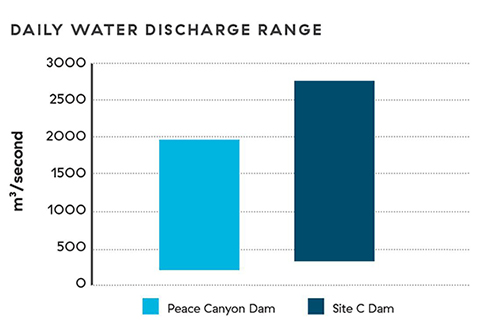Filling the reservoir
One of the last steps in building the Site C dam is to fill the reservoir. Reservoir filling will take about four months, widening the Peace River by an average of two to three times.
Filling the reservoir nav
Downstream effects
During reservoir filling and once the dam comes into service, Site C will have small effects on the Peace River flows downstream of the dam.
During the early stages of reservoir filling, Peace River flows directly downstream of Site C are expected to be low, near the project’s minimum licensed flow of 390 m3/second for about one month.
The low flow period may affect some Alberta ferry operations. We will communicate with officials in Alberta, who will notify ferry operators to plan for potential short operational outages when needed.

Water flows and levels
The Peace Canyon dam, located 85 kilometres upstream of Site C, normally discharges water within the operating range of 283 to 1,982 m3/second.
The Site C dam, with additional flow from local tributaries, will normally discharge water at a rate of 390 to 2,600 m3/second. Occasionally, Site C will need to discharge additional water from its spillways.
Downstream water levels will vary, depending on discharges from Site C, flow in downstream tributaries, and topographic features at different locations on the Peace River.
Water temperatures
Water temperatures in the Peace River immediately downstream of Site C will be slightly warmer than existing conditions between July and January, with differences ranging between 0.3°C (July) and 1.5°C (January).
During the rest of the year, water temperatures in the Peace River just downstream of the Site C dam will be cooler than existing conditions, ranging between 0.4°C (March) and 0.9°C (June).
Water clarity
Downstream Peace River suspended sediments are expected to lessen. This would result in only small changes to the overall river, due to the large sediments coming from downstream tributaries.
There will be increased suspended sediment levels during the beginning of reservoir filling, lasting several months as water picks up the sediment from previously dry land. During this time, we will monitor Peace River suspended sediment levels.
Fish habitat and methylmercury levels
Overall, we predict an increase in fish population, mainly due to an increase in mountain whitefish. We expect several other species to remain and potentially expand further into Alberta after the Site C dam is built.
To address the risk of fish stranding, we’re enhancing downstream fish habitat to provide permanently wetted protected channels for fish spawning and rearing.
The process of converting inorganic mercury to methylmercury will temporarily speed up when the reservoir is filled, due to rapid decomposition of soil and vegetation on previously dry land.